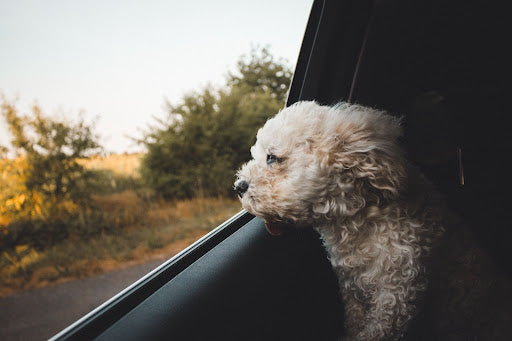
Safe Car Travel For Dogs
Share
What is the safest way for a dog to travel in a car?
Most people nowadays are pretty clued up on how to travel safely by car. We understand the importance of making sure all the passengers are wearing a seatbelt, and we know the do’s and don’ts of safe driving.
But what about when it comes to traveling with pets?
Whether you have a dog whose favorite park isn’t within walking distance, or an elderly pet who needs a vet appointment, traveling with your canine friend is sometimes unavoidable.
And when it comes to pet transportation, traveling by car is often the simplest and most affordable option.
Even if you can usually take your pet anywhere they need to go on foot, there may be occasional times in their life when long-distance travel is necessary - such as if you relocate across the country.
Another common reason for pet car travel is when taking your pet home for the first time, particularly if you have had to travel a long way to collect a puppy of an unusual breed.
In this article, we’re breaking down our top tips for travelling with a dog in your car. Read on to find out how to ensure your pet travels safely and comfortably on both short and long-distance journeys.
Our top tips for transporting dogs in cars
When it comes to pets, there are several steps you can take to make sure your furry friend is happy and safe throughout the journey - even if they are naturally nervous or hyperactive.
Take a look at the most important steps for traveling with your dog by car here:

1. Make sure you know the rules.
If you know you’re going to be traveling by car with your dog, it’s important to brush up on your knowledge of local and national laws regarding pet car safety.
These laws may differ in different locations, so it’s best to double-check if you are unsure.
In general, laws, regulations, and official advice relating to traveling by car with dogs all focus on the same key issues - making sure your pet is safe and not likely to be a dangerous distraction to the driver.

2. Safely secure and restrain your dog.
There are a number of options for restraining your pet safely during a car journey.
The best option for you will depend on the size of your pet, the vehicle you are driving in, and your personal preference.
One option is a harness that allows you to secure your pet to the rear or front passenger seat without them feeling restricted. This will prevent them from jumping up suddenly, or being thrown forward if you need to suddenly brake.
When using a harness at the rear of the vehicle, we also recommend using a car seat cover that is specially designed for dogs. Not only will a good-quality seat cover protect the upholstery in your car from scratches and stains, but it will also provide an anti-slip surface that will help your pet to stay comfortable and safe throughout car journeys.
After all, the last thing you or your pet want is them sliding up and down the seat every time you turn a corner!
A second option for securing your pet is using a crate or pet carrier. Some pets may feel more comfortable and relaxed traveling this way, particularly if they often use the same crate or carrier and recognize the familiar scent.
For large breeds, many owners opt to place their dog in the trunk during car travel. Note that it is illegal to transport your pet in an enclosed trunk. If your pet is traveling at the rear of the vehicle you may need to consider purchasing a barrier to protect both them and yourself in the event of an accident.

3. Always put safety before fun!
We don’t want to be party poopers, but the reality is that some of the things pets love to do most in the car are unsafe for both them and their owners.
For example, even if your dog begs you, you should never let them stick their head out of the window.
As this article explains, this can be very dangerous for several reasons.
If your dog travels with their head out of the car window, they may be struck by an obstacle you are passing. They may also suffer an eye or facial injury as a result of debris thrown up by car tires. There is also a risk of damage to their ears - particularly in breeds with floppy ears.
Dogs have very sensitive ears and many breeds are prone to developing injuries as the skin of the ears becomes irritated, causing trauma and swelling.
The most obvious and serious risk associated with this habit is your pet falling out of the vehicle. This could cause serious injury and even death.
You might think that falling out is unlikely, but the reality is that your dog can quite easily lose their balance when you drive over rough terrain or turn suddenly - or simply because they become overexcited by something they see or smell.
Another no-no for travelling with dogs is allowing them to sit on your lap as you drive. This can cause a serious distraction and is an unsafe place for them if you happen to have an accident or need to brake sharply.

4. Consider the temperature.
We all know that leaving a dog in a car on a hot day can be extremely dangerous. It’s worth noting that pet owners also need to consider the temperature in the car whilst driving, too.
Make sure you pack plenty of water so that your dog doesn’t become dehydrated.
You can use the car air conditioning, as long as your pet is not sitting directly in front of it, and you can also wind down the windows slightly to let cooler air in (as long as the gap is far too small for your dog to escape or fall out of).

5. Help them feel relaxed.
If you have an anxious dog who is not used to car travel (or has never managed to get used to it!) you might want to consider giving them some dog calming treats.
You can also see a vet about prescribing anti-sickness medication if this is something your pet suffers from during car journeys.
Another way to help them relax is by giving them a favorite blanket or soft toy to travel with. The familiar sight and smell will help them to feel safer and more at home.

6. Allow extra time for your journey.
Traveling with a dog is a little like traveling with a small child - it’s important to plan opportunities to take rest breaks as needed.
Allow additional time for the journey so you don’t feel rushed and can stop to let your dog stretch their legs and relieve themselves.
Hyperactive dogs and those with a lot of energy will probably find it a lot easier to sit calmly and quietly in the car if they have regular opportunities to run around and let off some steam too.
We hope you’ve found our top tips for dog car travel helpful!
If you’re looking for a durable, waterproof, and anti-slip car seat cover, we recommend DakPets Car Seat Cover for Dogs and Cats.
Suitable for most breeds, it also features integrated seatbelt openings so that the rear of your vehicle can be used simultaneously for canine and human passengers.
